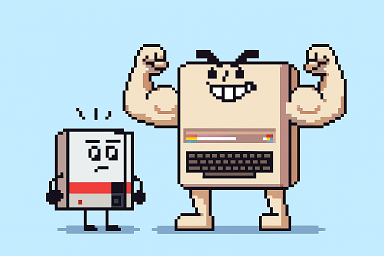I do think software piracy also was a large success factor. When I was 13 there was one major spot in my city where consoles and computers were sold (within a department store!), and people where “swapping” games even before they bought the hardware. I remember at least one of the store clerks having a small side business providing access to disks and tapes you could copy - right on the machines that were shown in store.
And I learned how to copy the C64’s basic rom to ram and mod small things even before I had the machine myself.
All the kids were gathering round the computers, the consoles were less attractive.
When I got my own C64 in 1983, my first game was Fort Apocalypse. It was not an original. You needed a boom box with dual tape decks to copy these.
until it didn’t. Nintendo and Sega destroyed computer gaming.
Depends on the time you mean but my old Amiga 500 begged to differ!
I wonder if history will repeat with PCs, and especially handheld PCs, a market which the Steam Deck effectively sparked into life, while Nintendo, PS, and Xbox crash and burn should there be a second Video Game Crash any time soon.
Because all three of the current console vendors aren’t doing great at all, in fact Xbox is basically already dead and even the Switch 2 seems DOA as far as exclusives go and it’s very much maligned by the press atm, while PC seems to be doing fine comparatively especially considering the success of the Steam Deck and the other PC handhelds which followed it.
Nintendo will not change, maybe they will get out of the US.
Sony may sack their console departments and stick to everything else.
Microsoft is already getting over with Xbox.
Steam Deck and clones will become the new handhelds, along with (possibly) Android gaming phones with controllers.
PC architectures will displace console ones.
In a world where you have a choice other than a walled garden, are you surprised people pick an open platform? Exclusives are never a good thing for the consumer, it is a way to control the user and deprive them of choice. About time people started wising up.
great question. i think it would be super difficult to predict the future of gaming technology at this point
Oh my beloved C64! I made my first “real” games with it, my buddies were artistic and made the music, sprites, animations, etc. I programmed the tools to make them!
The worst aspect of the C64 was that the hardware was a mostly undocumented mystery zone. As an early teen, I had the C64 programmer’s reference manual checked out of our library for 2 years!!! Doing any kind of advanced graphics meat PEEKing and POKEing random addresses and registers and interrupts to see what would happen. A nightmare! My hat’s off to all the demo scene folks that did ludicrous stuff
edit: My first released game was “Studmaster” replete with every horrible thing your mind is currently imaging lmao. I’m not proud of this now but it was pretty wild for two 14 year old kids in the 80’s to make a small-scale text/graphic adventure game and publish it
The worst aspect of the C64 was that the hardware was a mostly undocumented mystery zone.
This is simply false. The C64 was a completely open platform, everything was open, including how you programmed the special hardware directly. Even the included documentation was pretty good to get started, and included examples on how to program audio, graphics and sprites directly to the hardware.
For more advanced programming (assembly) you obviously needed to purchase the tools and documentation. The included book was only meant to get you started with the included BASIC. But the tools were cheap and documentation were extremely cheap compared to other computers, because it was a completely open platform.
The ability to have an assembler on a capsule in shadow ROM was extremely powerful.The philosophy of Jack Tramiel was to put the hardware in the hands of users, and let them do whatever they wished without limitations. No closed garden at all.
Exactly because of that Jack Tramiel was a fucking hero IMO. And no other computer had more hacks and programming examples available at the time. And I bet it was a huge reason for why C64 was by far the best selling home computer for years.Atari and Texas Instruments however at the time were closed, and therefore IMO useless.
Included book for C64:
https://www.commodore.ca/commodore-manuals/commodore-64-users-guide/I don’t ever remember seeing a list of PEEKs and POKEs. Guess it never occured to me that there was better documentation to be had. Every pin in the machine was clearly documented though.
No computer I know of ever came with an actual hardware reference.
However the concept is shown for instance on page 60, that shows peek and poke address for border and background color.
The C64 had a lot to get you started, way more than most, but it is still just to get you started.
If you want to get serious on a C64 you don’t peek and poke much, but program in assembly.
You are talking a lot of philosophical stuff, but the reality was when you wanted to get the low level hardware, there was very little documentation. Even banks of the technical documents had giant blanks saying these are a bunch of video registers and interrupts, basically good luck lol
I don’t sense that you have any actual experience programming on that platform, because if you did you’d know what I’m saying
but the reality was when you wanted to get the low level hardware, there was very little documentation.
The low level of what? Graphics sprites sound and IO were ALL documented!
Maybe horizontal and vertical smooth scrolling wasn’t in the included book, which is essentially just an introduction for beginners, but such things were absolutely released info by Commodore, and it was dead easy to do for that reason, such info was everywhere!I don’t sense that you have any actual experience programming on that platform,
I absolutely did, and I programmed sprites in assembly, and made a program we called sprite design, where you could design and animate sprites, which we never released, because we were under the false assumption that you didn’t release software until it was perfect.
Later when i didn’t use the C64 anymore, a friend of mine borrowed all my software, and came back absolutely ecstatic about how professional Sprite Design was, and was very puzzled he had never heard about it.
We made a build in help function using our own 90% efficient compression, we used self modifying code, and utilized the 6510 ability to switch off the ROM to have access to the RAM at that address space, and swapped where the character set was located and used our own 6 pixel wide character set, with an interrupt to give a tiny beep sound with key presses. The main structure was made with the Petspeed compiler, but everything surrounding the sprite animations was assembly. ( fuck 8 bit programming 😜 ) I made pretty sophisticated algorithms to make the weird 8x8 or 4x8 graphics format in color easier and faster to work with.
The C64 was amazing for its time for its speed and hardware capabilities. Despite being a machine that ran slightly below 1 MHz it was quite fast for its time.You just probably isn’t aware that all that was openly available on the C64 wasn’t on most other computers of the time.
A collection on C64 books: https://archive.org/details/commodore_c64_books
An example of a book describing assembly and hardware registers:
https://archive.org/details/Assembly_Language_Programming_With_the_Commodore_64_1984_Brady_Communications_Company/mode/2upBut also there was a ton of info released in magazines like RUN etc.
I’m not sure what info exactly you think was lacking? Except of course there were a few things that were possible that even the creators of the chips were unaware of, But was figured out by hackers. Such things can obviously not be part of the official documentation.





